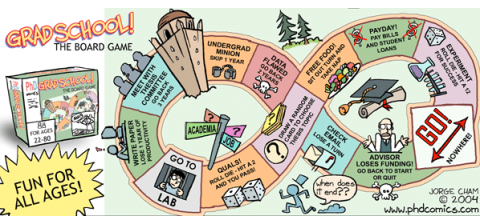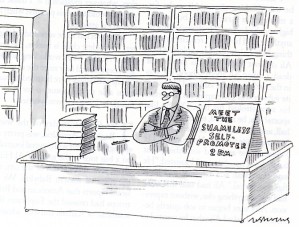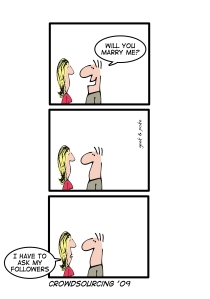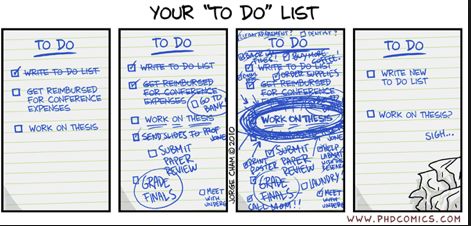Author Archive
Put a fork in me, I’m done!
Posted on: May 28, 2013
 I started this blog about 3 1/2 years ago when I decided to change paths and go off in pursuit of a Ph.D. On May 5th I graduated and have the diploma to prove it. For anyone thinking about going back to school as a more “seasoned” student here’s my top 10 list for perspective Ph.D.’s:
I started this blog about 3 1/2 years ago when I decided to change paths and go off in pursuit of a Ph.D. On May 5th I graduated and have the diploma to prove it. For anyone thinking about going back to school as a more “seasoned” student here’s my top 10 list for perspective Ph.D.’s:
10. Leverage your topic in everything you do. Figure out how to start writing about your research area in your classes even if you don’t have data. I was amazed at how much I was able to reuse from the lit reviews, theory exploration, and proposals that were created as part of my coursework.
9. Remind yourself that you are here to learn. Just because you have 20+ years of industry experience, that doesn’t really matter. Put that in your back pocket for now. Scholarship is a different ball game, so be open to what you don’t know, admit that you don’t know it, and actively seek out advice from those who are doing it.
8. You can’t read everything. At some point you just have to stop or you’ll never finish. (TIP: One thing to never stop reading is Ph.D. comics. This guy is right on and will put a smile on your face.)
7. Talk about your ideas no matter how half-baked. In fact, the most important time to talk about them is when they are just forming. Find a buddy who is working on a similar topic then meet weekly to discuss your work. Just talking about what you’re doing is eye-opening in terms of how difficult it can be to clearly articulate your research. (CAUTION: Alcohol should not be involved, it only makes half-baked ideas sound way better than they really are.)
6. Plan your work and work your plan. Here’s where being more “seasoned” is a benefit. Create a 4 year plan that outlines semester by semester the classes you want to take, the conferences you want to submit papers to, the key milestones of your program, and the courses you want to teach. Then regularly evaluate how you’re doing against your plan. It will likely change, but it will help you from waking up 4 years later and still not being at the finish line.
5. Dissertations are like large software projects, they often fail because people keep adding new features. Avoid the moth in a light-bulb factory effect of adding in new stuff just because you’ve become enamored with it. Focus. Focus. Focus. Here’s where your advisor will be key.
4. Speaking of advisors, s/he will make you or break you. So be sure you have a collaborative relationship, that she knows your area of study, that she has the time to devote to you (meeting every other week potentially), and that she’s not slated for a sabbatical right as you’re reaching the end. She will also be instrumental in finding you a job, so pick someone that has and extensive network and is well respected in the field you want to enter.
3. Expect to be anxious. This process was a crazy up and down experience. It was the first time in a long time that I couldn’t apply my past business experiences directly to the task at hand (or just wing it based on past knowledges). So expect to wake up in the night with regular “Oh Shit!” moments. They will pass (and come back again), so just know it’s part of the process. (TIP: Yoga breathing helps as does alcohol but both are only temporary.)
2. Write down what motivated you to do this in the first place and what your end goal is. Then, revisit it often. Academia presents many different opportunities and your advisor and the culture of the institution you are studying at may value different things than you do. You can easily get caught up in what others’ think is important and end up spending time that ultimately doesn’t advance your personal goals.
1. Get your Ph.D. for you and be “all in.” You have to remain motivated. You have to do all the work yourself. It’s a very lonely process at times, so you have to be your own best advocate and cheerleader. (TIP: Having a spouse who’s willing to take up the slack and deal with late nights and braindeadness is essential.)
In the end, it’s an amazing journey and I’m glad that I’m on the other end of that train.
 Excited to say that just before Christmas my research was featured in an article on MIT Sloan Management Review’s Blog Improvisations. The author Robert Berkman discusses my paper from this years AMCIS (Americas Conference on Information Systems) Conference.
Excited to say that just before Christmas my research was featured in an article on MIT Sloan Management Review’s Blog Improvisations. The author Robert Berkman discusses my paper from this years AMCIS (Americas Conference on Information Systems) Conference.
It’s exciting to have what I’m working on noticed (it also great timing considering I’ll be defending next month).
OK, self-promotion complete, back to writing.
What does Charlton Heston and crowdsourcing have in common?
Seems Microsoft is attempting to “integrate human expertise permanently into our writing tools” with a plug in that leverages crowdsourced labor via Mechanical Turk to create a better spell/grammar checker.
Mechanical Turk is an on-demand workforce platform that leverages the crowd (anyone, anywhere, who’s interested and connected to the Internet) to compete routine, time-consuming tasks that are difficult for computers but easy for humans – commonly referred to as human intelligence tasks or HITs.
Turkers – as the workers on the site are called – are paid nominal fees to complete HITs. Often one group may complete a task and another verifies quality of others.
How does it work?
Soylent is an add-on that leverages Mechanical Turk to copy-edit your document. Currently in Beta, Soylent attempts to “embed human knowledge into a word processor.”
Soylent uses a program design pattern called “Find-Fix-Verify” that splits task into smaller tasks that can be done in stages. Theory is that this decreases costs but increased quality.
Features include:
- Shortn – Turkers cut out extra words and shorten your manuscript
- Crowdproof – leverages the crowd to check spelling grammar and provide suggestions about style
- The Human Macro – allows you to describe the types of changes you want (e.g., change all to past tense), then turn it loose to the crowd
Ask not what the you can do for the people, but what the people can do for you.
 While Clippy came with Microsoft Word, Soylent requires payment to crowdworkers.
While Clippy came with Microsoft Word, Soylent requires payment to crowdworkers.
Costs are descried as “small” or “just a few cents” so it’s hard to really estimate real costs. The creators say it costs about $1.50 per paragraph.
Are you game?
Check out the short YouTube video.
You can join the Beta to see what the people can do for you. If you do, let me know what you think.
The museum of endangered sounds
Posted on: June 10, 2012
The impact of technology on our lives.
When we think about technology, we often think about all the new things that it brings to our lives. But, Brendan, a student at Chattanooga State Community College, thinks about technology differently. Brendan started wondering about what we may be losing. And in doing so came up with the great idea of archiving sounds that are “endangered” because of new technology.
Dubbed the Museum of Endangered Sounds, Brendan has a set of 18 photos that can be clicked to play the corresponding sound. Depending on your age you may or may not have even heard of some of these sounds. Think about the sound of a modem connecting, the sound of a rotary dial phone, or even…”We’re sorry, your call cannot be completed as dialed” (I never liked that lady).
You can almost see the game show now, “Name that Endangered Sound.” The cheesy game show host invites the next two contestants up to the podium, he signals for the sound to play while the two contestants hover their hand over the red plunger button in anticipation. The sound begins…a hand slaps the button…the contestant says…”A busy signal.” Woohoo, 100 points for your team.
Or, how about adding sounds to the oh so popular trivia nights at all the local bars (something us older folks would kill at).
Saving a piece of technological history.
I never though about how if we fail to capture these sounds they may disappear forever. Would loosing the sound of a modem connecting be a horrible thing, probably not. But, these sounds, or lack thereof, tell the story of the digital age; how quickly technology is advancing and with it changing the very noises we encounter in our daily lives.
Think about all the sounds we could collect by crowdsourcing the whole site. What might we learn? Do the sounds that are disappearing differ by countries? What sounds have disappears that we here in the U.S. don’t even know about? Have any sounds come back?
It’s not just sounds that are endangered (and even extinct). It’s things too.
 Maybe Brendan needs to create a companion site, “Name that Endangered Thing.” After all, it’s not just sounds that we may be loosing forever, it’s also things. Think about some of the “things” that are disappearing. For example, do you know what this red thing is? We certainly have little use for it anymore now that we listen to digital music.
Maybe Brendan needs to create a companion site, “Name that Endangered Thing.” After all, it’s not just sounds that we may be loosing forever, it’s also things. Think about some of the “things” that are disappearing. For example, do you know what this red thing is? We certainly have little use for it anymore now that we listen to digital music.
How about the plastic folding photo holder thingy that you used to add to your wallet? Heck I couldn’t even find a photo of one on the Internet. Which made me think that not only are sounds/things being endangered, depending on how long ago they existed (and we’re talking decades not centuries), they might not even have a presence on the web. And for many younger folks that means they probably never existed anyway.
Think about what other sounds Brendan might add to his site? What other “things” are endangered or even extinct?
————————-
SPOLIER: It’s a spindle for a 45 RPM record (which have pretty much also disappeared).
Thought o’ the day
Posted on: January 6, 2012
So much about innovation is changing. Globalization, increased need for speed to market, increased costs, mobile workforce, and maybe most importantly the proliferation of the Internet and online collaborative tools. I think O’Reilly’s quote sums it up nicely.
“The central principle behind the success of the giants born in the Web 1.0 era who have survived to lead the Web 2.0 era appears to be this, that they have embraced the power of the web to harness collective intelligence.”
O’Reilly, 2005
Crowdsourcing #1 for 2012
Posted on: August 2, 2011
 As a researcher studying crowdsourcing I was excited to see that Haydn Shaughnessy of Forbes magazine predicts that crowdsourcing will be top of mind for companies in 2012. While I agree that crowdsourcing examples are on the rise, I’m not sure I agree that crowdsourcing is a “fail safe” option that is a “mature” as Haydn suggests.
As a researcher studying crowdsourcing I was excited to see that Haydn Shaughnessy of Forbes magazine predicts that crowdsourcing will be top of mind for companies in 2012. While I agree that crowdsourcing examples are on the rise, I’m not sure I agree that crowdsourcing is a “fail safe” option that is a “mature” as Haydn suggests.
We’ve only begun to examine the economic impacts of crowdsourcing initiatives on the corporate bottom line. Some studies are finding that turning to the crowd has reduced cost and time for product innovation and problem solving, improved quality, and increased market acceptance of new products. In fact, TopCoder a site that runs contests for developing complex software applciations reports that projects typically requiring over a year of development have been completed in slightly over five months. Additionally, TopCoder programs average .98 bugs per thousand lines of code, significantly better than the industry standard of six per thousand. These initial findings are promising, but more research is needed to determine the true benefits to corporations.
While potentially more economical than traditional innovation methods, crowdsourcing does not come without costs. It is not a “build it and they will come” solution. Success requires defined business goals, an understanding of crowd dynamics as well as collaborative technologies. Additionally, those who are getting the crowd to participate are often finding it difficult to sort through and evaluate all the information and ideas that are generated.
One of the biggest hurdles is organizational culture. I saw a similar issue when working with companies to leverage social media for marketing initiatives. Success at leveraging the crowd requires an organizational culture that embraces open methods from the top down and is willing to give up some control. Exposing yourself and your company to the crowd can be scary and isn’t without risk. Lawyers raise concerns about leakage of trade secrets and issues related to intellectual property. Employees may feel they are becoming obsolete and fear for their jobs. And, executives may pull the plug when they encounter negative feedback or comments from customers.
Every day there are new and different uses of the crowd for innovation. While companies like P&G and intermediaries like InnoCentive seem to have it down, most are only beginning to experiment with leveraging the crowd for innovation. I do agree that crowdsourcing may be an excellent opportunity for companies to supplement or even replace their current innovation initiatives – saving money and time in the process. But currently we have only scant evidence of the how best companies can extra value from the crowd.
(Cartoon (c) Geek and Poke, 2009)
I had the pleasure of attending the PDMA Co-Creation conference in Arizona in June. The first day was hosted by Local Motors. Local Motors is a company that crowdsources specialty vehicles. This business model provides an interactive online platform for crowd-created automotive innovation. Typically, traditional auto manufacturers take 6 years on average to bring a car concept to market. Local Motors is able to reduce that substantially.
 They recently competed in a competition held by DARPA to create a combat support vehicle for delivery and evacuation missions. Leveraging a chassis created in a different Local Motors crowdsourced vehicle, DARPA invited the general public to design the size, shape, and features of the car. Local Motors hosted the contest providing requirements, engineering guidelines, deliverables, “ignition kits” with necessary design tools, and a discussion forum on their website. Local Motors experts work with the crowd to ensure specifications are met and all cars meet safety requirements. Prize money of $1500 for 1st place, $1500 for 2nd, and $1000 for 3rd were given to the best design. The car was designed in 4 months, and built in 14 weeks. Significantly faster and at less expense than typical military vehicles. It is combat ready and meets all specs. Even President Obama got in the mix.
They recently competed in a competition held by DARPA to create a combat support vehicle for delivery and evacuation missions. Leveraging a chassis created in a different Local Motors crowdsourced vehicle, DARPA invited the general public to design the size, shape, and features of the car. Local Motors hosted the contest providing requirements, engineering guidelines, deliverables, “ignition kits” with necessary design tools, and a discussion forum on their website. Local Motors experts work with the crowd to ensure specifications are met and all cars meet safety requirements. Prize money of $1500 for 1st place, $1500 for 2nd, and $1000 for 3rd were given to the best design. The car was designed in 4 months, and built in 14 weeks. Significantly faster and at less expense than typical military vehicles. It is combat ready and meets all specs. Even President Obama got in the mix.
A similar contest was held by Local Motors to crowdsource a desert race vehicle called the Rally Fighter. What’s interesting about the Rally Fighter is it consists of m ostly off the shelf parts. GM engine, Honda Civic taillights, Miata door handle, etc. By leveraging existing parts Local Motors avoids costs associated with manufacturing. The car is built in a limited run (2000) at Local Motors microfactories. Purchasers go to the microfactory for 2 3-day weekends to build the car from the chassis up. Makers can also create a custom car wrap with whatever design they choose. After the 2nd weekend the new owner drives the car off the lot or ships it home.
ostly off the shelf parts. GM engine, Honda Civic taillights, Miata door handle, etc. By leveraging existing parts Local Motors avoids costs associated with manufacturing. The car is built in a limited run (2000) at Local Motors microfactories. Purchasers go to the microfactory for 2 3-day weekends to build the car from the chassis up. Makers can also create a custom car wrap with whatever design they choose. After the 2nd weekend the new owner drives the car off the lot or ships it home.
What’s up next? Local Motors announced at the conference they will be crowdsourcing an electric vehicle. I believe this will be a wake-up call for auto manufacturers. Stay tuned.



